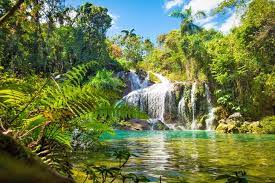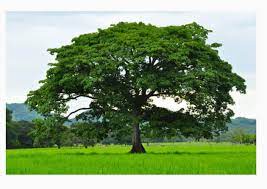
“SIGUARAYA”, EL ARBOL SAGRADO EN LA CULTURA AFRO-CUBANA Y LA RELIGION YORUBA. PHOTOS/VIDEOS.
Sí, la siguaraya es un árbol sagrado en la cultura afrocubana y en la religión yoruba. En la Santería cubana, la siguaraya representa las siete potencias, o los siete Orishas principales de la religión yoruba. Shangó, el dueño principal del árbol, está asociado al trueno y al rayo, por lo que también se le conoce como Siete Rayos.
La siguaraya es una planta meliácea con hojas opuestas, ovales y coriáceas, flores axilares en racimos y cápsulas coriáceas y rojizas. Se usa en medicina y en la industria.
LOS BABALAOS CUBANOS
Los ‘Santeros’ cubanos aseguran que este es un árbol santo, según la tradición Yoruba o Lucumí de la respetable religión afrocubana. Es por ello que la Siguaraya se ha convertido para los cubanos en uno de sus árboles de mayor misticismo, tanto para los creyentes, como para los más incrédulos.
La siguaraya es conocida como “rompe camino” porque – siempre según las creencias afrocubanas – tiene la fuerza para destruir el fúmbi (muerto) enemigo; “tapa camino”, porque evita que este interfiera en la senda de su nfumo y lo obstrucciones y “abre camino” porque desbarata todo lo malo y facilita la vida del hombre abriéndole paso.
En esa dificultad para arrancarla, a pesar de ser un árbol tan común, radica quizás el origen de la expresión tan cubana “!Este es el país de la siguaraya!” que se utiliza para hacer patente la exasperación ante la imposibilidad de despojar algún mal sufrido o desquitarse ante un agravio.
Este frondoso árbol de la familia de las meliáceas, que crece silvestre y fuerte en los campos de la Isla, alcanza entre ocho y diez metros de altura y es considerado como sagrado para las religiones afrocubanas.
Los habitantes de la Isla conocen bien los atributos de la siguaraya (quizás por eso la mientan tanto) debido a los múltiples atributos religiosos que los practicantes de la santería cubana y de la regla de palo monte le reconocen.
En la medicina popular la siguaraya es muy apreciada y se utiliza para las afecciones artríticas, del aparato urinario y por su acción purgativa y beneficiosa para las enfermedades venéreas.

LA MATA SIGUARAYA
La Siguaraya, de nombre científico “Trichilia havanensis”, descubierta en 1759 por el botánico holandés Nikolaus Joseph von Jacquin, es un árbol de abundante follaje y flores blanco verdosas, que crece en Cuba y según la religión africana practicada en la isla caribeña, pertenece al orisha o deidad mayor conocido como Shangó.
Según la creencia santera, esa planta es considerada mágica. Se considera el primer “palo” al que después de saludar a los Cuatro Vientos, saludan ‘los mayomberos’ en el monte. ‘Esa planta abre los caminos y la suerte de quienes la invocan, pero los cierra para el enemigo’ y en la crencia de los santeros posee siete potencias representadas por el culto yoruba en las figuras de Yemayá, Elegguá, Ochún Obatalá, Orúnla, Oggún y Changó, por cuya razón es considerado como el primer palo de monte. Contiene a los siete orishas principales de la religión Yoruba.
La Siguraya, localizada a orilla de rios y arroyos, a lo largo de los senderos y en las cercanías de los bosques de baja altura, florece entre enero y abril y es llamada también Siete Rayos, en referencia a Chango, dios del trueno y el fuego, llevado a través del sincretismo religioso a la imagen de la Santa Bárbara del catolicismo.
Esta planta silvestre a la cual se abribuyen poderes sobrenaturales, no es sólo patrimionio de los cubanos, tambien en México, Costa Rica -donde se le conoce como Uruca- asi como en otras islas del caribe.
LA SIGUARAYA EN LA MUSICA CUBANA
Con el tema “Mata Siguaraya”, del compositor y pianista cubano Lino Frías, fallecido en Nueva York en 1983 y cantada magistralmente por Benny Moré, el árbol brujo ganó fama internacional y la canción ha sido interpretado por otros, pero ninguno hasta ahora logró la entonación y melodía imprimida por el inmortal “Bárbaro del Ritmo”.
Sobre la siguaraya cantó Benny Moré en un antológico tema que era “una mata tan sagrada que sin permiso no se podía tumbar”.

“SIGUARAYA”, THE SACRED TREE IN AFRO-CUBAN CULTURE AND THE YORUBA RELIGION. PHOTOS/VIDEOS.
Yes, the siguaraya is a sacred tree in Afro-Cuban culture and in the Yoruba religion. In Cuban Santeria, the siguaraya represents the seven powers, or the seven main Orishas of the Yoruba religion. Shango, the main owner of the tree, is associated with thunder and lightning, which is why it is also known as the Seven Rays.
The siguaraya is a honey plant with opposite, oval and leathery leaves, axillary flowers in clusters and leathery and reddish capsules. It is used in medicine and in industry.


THE CUBAN BABALAOS
The Cuban ‘Santeros’ assure that this is a holy tree, according to the Yoruba or Lucumí tradition of the respectable Afro-Cuban religion. That is why The Siguaraya has become one of the most mystical trees for Cubans, both for believers and for the most skeptical.
The Siguaraya is known as “road breaker” because – always according to Afro-Cuban beliefs – it has the power to destroy the enemy fúmbi (dead); “road stopper” because it prevents the enemy from interfering in the path of its nfumo and obstructing it; and “road opener” because it destroys all evil and makes life easier for man by opening a path for him.
In this difficulty in uprooting it, despite it being such a common tree, lies perhaps the origin of the very Cuban expression “This is the country of the Siguaraya!” which is used to express the exasperation at the impossibility of getting rid of some evil suffered or to get even with an insult.
This leafy tree from the Meliaceae family, which grows wild and strong in the fields of the Island, reaches between eight and ten meters in height and is considered sacred by Afro-Cuban religions.
The inhabitants of the Island know well the attributes of the siguaraya (perhaps that is why they lie about it so much) due to the multiple religious attributes that the practitioners of Cuban Santeria and the palo monte rule recognize in it.
In popular medicine, the siguaraya is highly appreciated and is used for arthritic conditions, urinary tract conditions and for its purgative action and benefits for venereal diseases.
THE SIGUARAYA
The Siguaraya, scientific name “Trichilia havanensis”, discovered in 1759 by the Dutch botanist Nikolaus Joseph von Jacquin, is a tree with abundant foliage and greenish white flowers, which grows in Cuba and according to the African religion practiced on the Caribbean island, belongs to the orisha or major deity known as Shango.
According to the Santeria belief, this plant is considered magical. It is considered the first “stick” that after greeting the Four Winds, the ‘mayomberos’ greet in the mountains. ‘This plant opens the paths and the luck of those who invoke it, but closes them for the enemy’ and in the belief of the Santeria it has seven powers represented by the Yoruba cult in the figures of Yemayá, Elegguá, Ochún Obatalá, Orúnla, Oggún and Changó, for which reason it is considered the first stick of the mountain. It contains the seven main orishas of the Yoruba religion.
The Siguraya, found on the banks of rivers and streams, along trails and near low-lying forests, blooms between January and April and is also called Siete Rayos, in reference to Chango, god of thunder and fire, brought through religious syncretism to the image of Saint Barbara of Catholicism.
This wild plant, which is believed to have supernatural powers, is not only the heritage of Cubans, but also in Mexico, Costa Rica – where it is known as Uruca – as well as in other Caribbean islands.
THE SIGUARAYA IN CUBAN MUSIC
With the song “Mata Siguaraya”, by the Cuban composer and pianist Lino Frías, who died in New York in 1983 and sung masterfully by Benny Moré, the witch tree gained international fame and the song has been interpreted by others, but no one until now has achieved the intonation and melody imprinted by the immortal “Barbarian of Rhythm”.
About the siguaraya, Benny Moré sang in an anthological song that it was “a bush so sacred that it could not be cut down without permission”.

Agencies/ Wiki/ Arrajatabla/ TodoCuba/ Extractos/ Excerpts/ Internet Photos/ YouTube/ Arnoldo Varona.
www.TheCubanHistory.com
THE CUBAN HISTORY, HOLLYWOOD.



